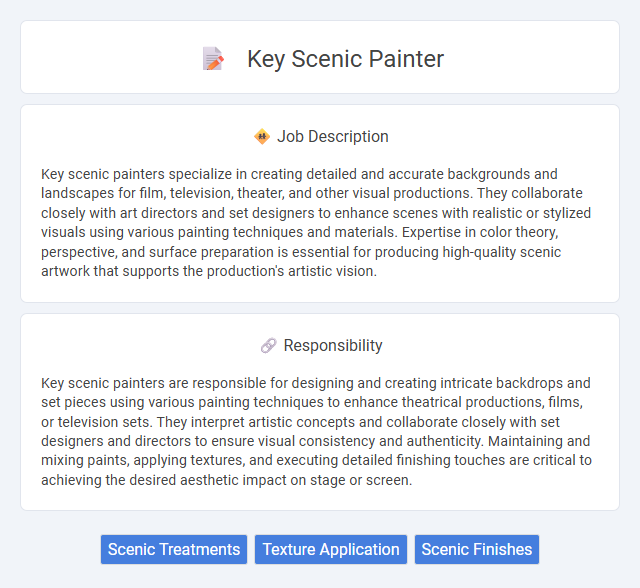
Key scenic painters specialize in creating detailed and accurate backgrounds and landscapes for film, television, theater, and other visual productions. They collaborate closely with art directors and set designers to enhance scenes with realistic or stylized visuals using various painting techniques and materials. Expertise in color theory, perspective, and surface preparation is essential for producing high-quality scenic artwork that supports the production's artistic vision.
Individuals with a strong attention to detail and a passion for artistic creativity are likely to thrive as key scenic painters, given the precision required in painting large-scale theatrical or film backdrops. Candidates with good physical stamina and the ability to work in varying environments, sometimes under tight deadlines, may find this job suitable. It is probable that those who prefer structured, repetitive tasks over dynamic, hands-on artistic work might struggle to find fulfillment in this role.
Qualification
Key scenic painters must possess expert skills in paint mixing, surface preparation, and large-scale brush techniques to achieve realistic textures and effects on theatrical, film, and television sets. Proficiency in color theory, safety regulations, and the use of various materials such as latex, acrylics, and specialty pigments is essential. Extensive experience in collaboration with scenic designers and the ability to interpret complex set designs into visually compelling backgrounds are critical qualifications for success.
Responsibility
Key scenic painters are responsible for designing and creating intricate backdrops and set pieces using various painting techniques to enhance theatrical productions, films, or television sets. They interpret artistic concepts and collaborate closely with set designers and directors to ensure visual consistency and authenticity. Maintaining and mixing paints, applying textures, and executing detailed finishing touches are critical to achieving the desired aesthetic impact on stage or screen.
Benefit
Key scenic painters likely enjoy benefits such as enhanced creative expression and the opportunity to work on diverse theatrical or film productions. They probably gain practical experience with various painting techniques and materials, boosting their artistic portfolio. This role may also offer collaborative environments that foster professional growth and networking within the entertainment industry.
Challenge
Key scenic painters likely face challenges related to mastering complex techniques required to create realistic and immersive stage environments. The job probably demands precision and creativity under tight deadlines, increasing stress and the possibility of errors. Navigating the unpredictability of materials and lighting conditions may also contribute to the role's difficulty.
Career Advancement
Key scenic painters play a crucial role in theatrical and film production by creating detailed, realistic backdrops that enhance visual storytelling. Expertise in various painting techniques and materials can lead to opportunities as lead scenic artists or supervisors, overseeing entire scenic art departments. Continuous skill development and networking within professional unions increase prospects for higher-profile projects and career growth.
Key Terms
Scenic Treatments
Scenic painters specialize in creating detailed scenic treatments that enhance theatrical, film, and event environments through expertly crafted textures, patterns, and color schemes. Their work involves applying techniques such as faux finishes, murals, and atmospheric effects to transform sets and backdrops into immersive visual experiences. Mastery of materials, surface preparation, and collaboration with designers ensures scenic treatments align seamlessly with the overall production design.
Texture Application
Key scenic painters specialize in texture application to create realistic surfaces on stage sets, using techniques such as sponging, stippling, and rag rolling to mimic materials like wood, stone, and fabric. They expertly blend colors and manipulate textures to enhance depth and visual interest, contributing significantly to the overall atmosphere of theatrical productions. Mastery of texture application directly impacts the audience's immersion, making scenic painting a vital component of stage design.
Scenic Finishes
A key scenic painter specializes in creating high-quality scenic finishes that transform plain surfaces into visually stunning backdrops for theater, film, and television productions. Their expertise includes applying textured paints, faux finishes, and intricate detailing to achieve realistic environments that enhance storytelling. Proficiency in color theory, surface preparation, and durable materials ensures long-lasting scenic finishes that meet production demands.
 kuljobs.com
kuljobs.com